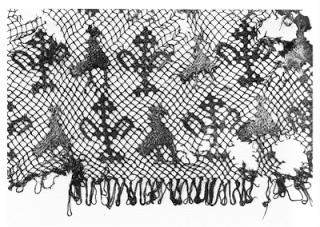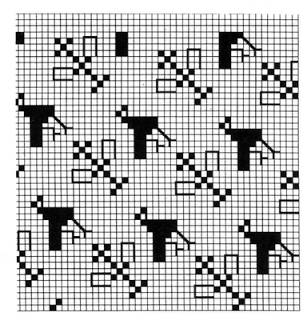Search the Blog
Latest Comments
Beatrix
Experiment!
23. April 2024
The video doesn´t work (at least for me). If I click on "activate" or the play-button it just disapp...
Katrin
Spinning Speed Ponderings, Part I.
15. April 2024
As far as I know, some fabrics do get washed before they are sold, and some might not be. But I can'...
Kareina
Spinning Speed Ponderings, Part I.
15. April 2024
I have seen you say few times that "no textile ever is finished before it's been wet and dried again...
Katrin
How on earth did they do it?
27. März 2024
Ah, that's good to know! I might have a look around just out of curiosity.
I've since learned that w...
Heather Athebyne
How on earth did they do it?
25. März 2024
...though not entirely easy. I've been able to get my hands on a few strands over the years for Geor...
Hairnets, part II
Hairnets. Yes.
Should you feel that the actual netting of rather large mesh is just not enough, even when combined with a bit of embroidery on cloth to sew on later - you can always do some embroidery straight on the mesh. Lacis, or filet lace, or however you want to call it, has a rather long history. The even ground made by the meshes of the net is a good groundwork for embroidery and allows for a nice contrast between open mesh and filled-in mesh.
A nice example for this is this fragmented net from the 13th or 14th century, with origin in West-Europe. There are two larger fragments and some smaller fragments preserved, with the largest piece measuring 13.5 by 43.5 cm. It is made from red silk for the knotted ground and embroidered with yellow and white silk.

picture clickable for larger version
On the bottom right side the large fragment has larger loops of thread, measuring 1.1 cm. The regular mesh size is 4 mm. If I read correctly, the red silk is dyed with madder, yellow was done with weld (Reseda luteola). The embroidered motif consists of alternating white birds and flower motifs, maybe fleurs-de-lis. Embroidery was done in rows, and three rows are still preserved. The flowers are embroidered by stitches around the mesh threads, while the bird motifs fill in the open mesh squares, using linen stitch.

With rather sparse embroidery, on a mesh that is a whopping 4 mm size, this would be a nice starter for your medieval hairnet collection, don't you think?
By the way, medieval silk nets really have small mesh sizes in comparison to later ones. A pattern book for lacis by Therèse de Dillmont is available on the net (German version of "Filet Guipure": Part 1 and Part 2), and she offers thread weight advice for mesh sizes between 7 and 11 mm.
Source for text and pictures:
DECONINCK, E., GEORGE, PH., DE JONGHE, D., Y., VAN STRYDONCK M. J., WOUTERS, J., VYNCKIER, J. und DE BOECK, J.: Stof uit de Kist: De Middeleeuwse Textielschat uit de Abdij van Sint-Truiden. Leuven 1991. Catalog Nr. 107, page 354.
Should you feel that the actual netting of rather large mesh is just not enough, even when combined with a bit of embroidery on cloth to sew on later - you can always do some embroidery straight on the mesh. Lacis, or filet lace, or however you want to call it, has a rather long history. The even ground made by the meshes of the net is a good groundwork for embroidery and allows for a nice contrast between open mesh and filled-in mesh.
A nice example for this is this fragmented net from the 13th or 14th century, with origin in West-Europe. There are two larger fragments and some smaller fragments preserved, with the largest piece measuring 13.5 by 43.5 cm. It is made from red silk for the knotted ground and embroidered with yellow and white silk.

On the bottom right side the large fragment has larger loops of thread, measuring 1.1 cm. The regular mesh size is 4 mm. If I read correctly, the red silk is dyed with madder, yellow was done with weld (Reseda luteola). The embroidered motif consists of alternating white birds and flower motifs, maybe fleurs-de-lis. Embroidery was done in rows, and three rows are still preserved. The flowers are embroidered by stitches around the mesh threads, while the bird motifs fill in the open mesh squares, using linen stitch.

With rather sparse embroidery, on a mesh that is a whopping 4 mm size, this would be a nice starter for your medieval hairnet collection, don't you think?
By the way, medieval silk nets really have small mesh sizes in comparison to later ones. A pattern book for lacis by Therèse de Dillmont is available on the net (German version of "Filet Guipure": Part 1 and Part 2), and she offers thread weight advice for mesh sizes between 7 and 11 mm.
Source for text and pictures:
DECONINCK, E., GEORGE, PH., DE JONGHE, D., Y., VAN STRYDONCK M. J., WOUTERS, J., VYNCKIER, J. und DE BOECK, J.: Stof uit de Kist: De Middeleeuwse Textielschat uit de Abdij van Sint-Truiden. Leuven 1991. Catalog Nr. 107, page 354.
Comments
No comments made yet. Be the first to submit a comment



